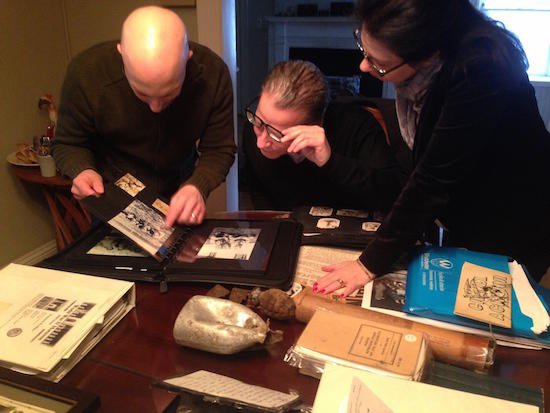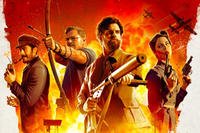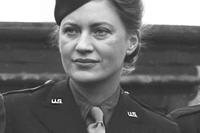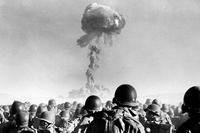
By Patrice O’Shaughnessy
The gray February day made the dining room of John Lozito’s home in New Rochelle, N.Y. seem even more like a memorial.
The table was laid out with a battered canteen, an old grenade and other battlefield artifacts from 70 years ago. An olive green jacket with a red, yellow and blue shoulder patch with the insignia of the 9th Armored Division-- a tank with a lightning bolt through it—was on display.
The room had that smell of history found in old paper -- newspaper clippings, documents, military records, well-creased letters, and photograph albums with thick black pages holding once black-and-white, now sepia, images.
There were pictures of Lozito’s great-uncle, Dominick Posillipo, and other soldiers of C Company of the 27th Armored Infantry Battalion, taken while they were training in the Mojave Desert to fight Hitler in Europe.
I and my brother and my daughter brought our own crumbling albums with pictures of my father, Denis O’Shaughnessy, and his Army buddies in C Company, of the 27th Armored Infantry Battalion, during training.
It was a reunion of sorts. We had never met, but our kin were in the bloody snow of the Ardennes Forest in the battle that led to the Allies’ victory in World War II five months later in May, 1945.
They are both dead, his uncle and my father, but we longed to know if they had known each other, if they were more than just passing soldiers in a company of 150 men.
John never knew his uncle. Dominick Posillipo never returned from the war. His remains were never found. John’s grandfather quietly mourned his dead brother until he himself died, instilling in John a need to find resolution.
Our father came home in 1945 and raised seven children until he died of a heart attack in 1977. His 17 grandchildren, including my daughter, Alannah Fay, never knew him.
Last December, around the 70th Anniversary of the Battle of the Bulge, John had come upon an article I wrote in 2009 for the New York Daily News, about my father’s war experience. John saw he was in the same company as his uncle, and tracked me down on the Internet. He lives about three miles from me.
So as we sat at his table, we opened our photo album, and there were several photos of my father with the same soldier. On the back of them my father had written “Me and Frank. He is a nice guy.”
John said, “That’s Frank Noe, he was Dominick’s best friend! He was in the foxhole with him when he died!”
In John’s album, there were photos of Dominick and Frank. John had talked to Frank about 10 years ago, and found out Frank had been beside his uncle when he was killed. An artillery shell hit their machine gun position near Steine Bruck, Belgium, which the 9th Armored was helping to capture as part of the pivotal Battle of St. Vith.
We sifted through the photos, and John found one of my father and Frank and seven other young men, all wearing helmets and combat gear and clutching rifles. My father was in the back row, looking stern and serious, and Frank was lying on the ground in front. There was a soldier kneeling in front of my father, with his hand protectively on Frank’s shoulder.
“That’s my uncle,” said John.
His eyes filled. My brother Mark’s eyes filled. So did mine.
This was a photograph of the half-track team. Both of our loved ones were on the same half-track. My father was the driver and Dominick was an assistant machine gunner. They sat just a few feet apart as they rode into hell in December 1944.
Dominick died on Dec. 17, the second day of the Battle of the Bulge and the first day of fierce fighting. He was posthumously awarded the Bronze Star Medal.
On the same day Dominick died, my father earned a Bronze Star of his own. He had pulled a wounded man off an area pocked with mines.
John found another photo of my father with his uncle. My father is in his dress uniform, his face serious. Dominick wore his usual slight smile. They had obviously been friends.
We studied photos of each soldier posing against a halftrack during training in the California desert. They could never have imagined then how cold they would be a year later, in leather boots and cloth coats in the frozen woods, blue-collar guys facing Hitler’s best-trained and best-equipped soldiers -- SS troops and Panzer divisions.
We shivered to think about it, looking out John’s windows at piles of snow.
My father came home and led a life shaped by his experience. He could tell a faker a mile away, and had compassion equal to his New York City skepticism. He never made much money or had pricey possessions. He loved his family, and Christmas, and sitting on a beach, and being in a warm apartment on winter nights.
Uncle Dominick, of course, never got to enjoy those things. His brother and mother kept his picture in a place of honor, and his mother visited his grave every Sunday, never told there was no body in it.
Mark and I have each been to the Ardennes, marveling at the thickness and isolation of the forest, picturing my father as a young man huddling there, scared but determined. John has been there many times and tried to find his uncle’s remains. He befriended the old guys of the 9th Armored, but they are all gone now.
It was wonderful and almost eerie to feel such a bond with someone, through events of so long ago and so far away.
We felt a connection to John, almost like we found a cousin we had never known about. Telling him about our father and the life he gave us, and the stories he related about the Army and the war, brought his Uncle Dominick to life. And John’s mementos of his uncle and his vast knowledge of the 9th Armored’s role in history brought Denis to life for his granddaughter.
As John said, everything we have in this country is because of them, and all the Dominicks and Denises who fought in World War II.




